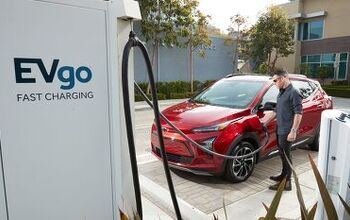UAW Contract Voting Has Been Mixed Thus Far

Unionized Ford workers in Louisville, Kentucky, and General Motors employees from Spring Hill, Tennessee, have voted no on the contract agreement reached by the United Auto Workers. While this only represents a fraction of the UAW votes needed to ratify the updated contract, it’s a sign that the deal hasn’t yet gone through and may not if the trend continues.
On Monday, production workers at the Ford Kentucky Truck Plant and Louisville Assembly Plant voted against the tentative agreement. The UAW had the nay vote pinned at 54.5 percent between the two facilities. But it looks as though the pickup truck factory was more-or-less evenly split on the matter.
By Tuesday, the UAW also announced that over two-thirds of the workers from GM’s Spring Hill Manufacturing had also voted against agreements union negotiators had previously made.
While we’ve covered the matter before ( and in greater detail) those terms include a 25-percent pay raise over the life of the contract, the restoration of the cost-of-living adjustment, additional time off, improved retirement benefits, and more.
UAW President Shawn Fain, who had been very aggressive in negotiating terms he deemed restored benefits previous union leadership lost, has been adamant that members should take the deal. The matter was reiterated during a speech he gave on November 8th.
Truth be told, media outlets appear to be making the situation appear more fraught than it actually is. Despite several unionized Ford plants voting against the proposed contract, the vast majority have already voted in support. It would take nearly every unionized facility Blue Oval has left to vote in opposition for ratification to fail.
Things appear to be much tighter over at General Motors. In addition to Spring Hill, the UAW has seen no votes moving forward at Romulus Propulsion Systems, Flint Truck Assembly, Pontiac Stamping, Tonawanda Powertrain, Marion Metal Center, and the Martinsburg Parts Distribution Center. The margins are much closer than what we’ve seen with Ford or Stellantis.
As the overall votes will change as more union members cast their ballots, there’s not much reason to dwell on GM’s current tally. But it’s close enough for there to be a chance that the contract may not be ratified at a nearly 52/58 split.
The divide seems to be driven primarily by production workers. Skilled trade employees tended to vote overwhelmingly in favor of the updated contracts, with rare exceptions taking place at facilities where line workers expressed strong opposition to the deal.
Our guess is that Ford and Stellantis (the latter of which still has quite a bit of voting left to do) will ratify the contracts. Meanwhile, we’ll all be trying to figure out why unionized GM workers seem more hesitant.
While we’ve started asking around, CNBC claimed it's been speaking with “industry experts and UAW members’” alleging that veteran workers are concerned they’re not receiving as much as newer employees under the terms of the deal. While this is supposed to pertain mainly to retirement benefits, they were likewise said to be concerned over some of the language used in the tentative agreements and a lingering distrust in union leadership after past corruption scandals of former leaders.
“I don’t think the tentative agreement goes far enough. I think it’s divisive. It doesn’t get rid of the tiers, and it doesn’t meet all of our needs as a whole,” Brian Keller, a former UAW presidential candidate in several past elections and an outspoken worker from Stellantis’ Mopar parts operations, told the outlet. “You gotta remember, we were stagnant from the time of the bankruptcy to 2015. We didn’t get no wage increases.”
That could just as easily be flipped into a win for the union, however. This is undoubtedly a juicer contract than the union had seen in years and strives to undo some of the concessions made since 2008. Fain has attempted to use those facts to convince UAW members to vote yes on the terms of the deal.
“I truly believe these are record contracts and are a major victory for our movement,” Fain said on Wednesday. “There were many in the media and in the corporate class who were saying we didn’t know what we were doing. And they thought we’d never get a deal. But then we got all three.”
He's undoubtedly correct there. The UAW aims to frame the contract as a massive victory it can use to encourage non-unionized plants to join its ranks. That remains a desirable outcome for a subset of the political class that believes the UAW will remain a staunch ally. But the matter has complicated the union's role just as much as some of its earlier corruption scandals and most companies don't want to have to deal with collective bargaining if there's an alternative. We've recently seen several automakers without union ties offering pay bumps in the wake of the UAW contract. While inflationary pressures likely played a role, the timing suggests the union issue was probably the biggest factor.
[Image: UAW]
Become a TTAC insider. Get the latest news, features, TTAC takes, and everything else that gets to the truth about cars first by subscribing to our newsletter.

A staunch consumer advocate tracking industry trends and regulation. Before joining TTAC, Matt spent a decade working for marketing and research firms based in NYC. Clients included several of the world’s largest automakers, global tire brands, and aftermarket part suppliers. Dissatisfied with the corporate world and resentful of having to wear suits everyday, he pivoted to writing about cars. Since then, that man has become an ardent supporter of the right-to-repair movement, been interviewed on the auto industry by national radio broadcasts, driven more rental cars than anyone ever should, participated in amateur rallying events, and received the requisite minimum training as sanctioned by the SCCA. Handy with a wrench, Matt grew up surrounded by Detroit auto workers and managed to get a pizza delivery job before he was legally eligible. He later found himself driving box trucks through Manhattan, guaranteeing future sympathy for actual truckers. He continues to conduct research pertaining to the automotive sector as an independent contractor and has since moved back to his native Michigan, closer to where the cars are born. A contrarian, Matt claims to prefer understeer — stating that front and all-wheel drive vehicles cater best to his driving style.
More by Matt Posky
Latest Car Reviews
Read moreLatest Product Reviews
Read moreRecent Comments
- Spectator Wild to me the US sent like $100B overseas for other peoples wars while we clammer over .1% of that money being used to promote EVs in our country.
- Spectator got a pic of that 27 inch screen? That sounds massive!
- MaintenanceCosts "And with ANY car, always budget for maintenance."The question is whether you have to budget a thousand bucks (or euro) a year, or a quarter of your income.
- FreedMike The NASCAR race was a dandy. That finish…
- EBFlex It’s ironic that the typical low IQ big government simps are all over this yet we’re completely silent when oil companies took massive losses during Covid. Funny how that’s fine but profits aren’t. These people have no idea how business works.


































Comments
Join the conversation
The votes at the GM Arlington Assembly came in yesterday, with nearly 61 percent voting yes. That pushes GM's total Yes votes to 54 percent. It looks like the workers at all the three Detroit automakers will approve their contracts.
Workers at the Mack truck plant have ended their 39-day strike, approving their contract.